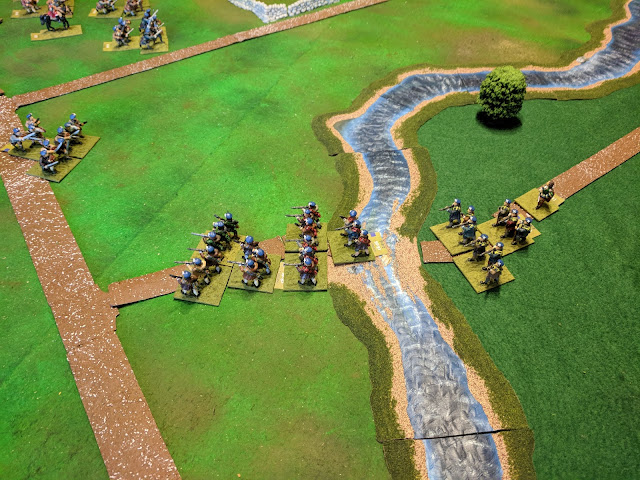We met last night for a first game of Archon 2 for us ..
David (left, provider of the 25mm figures) played Romans, and Peter had the short straw of Celts.
David (left, provider of the 25mm figures) played Romans, and Peter had the short straw of Celts.
The game started bizarrely .. the first THREE D20 roll-offs all resulted in ties! This was going to be a long game .. :-)
In the first phase, the Romans moved their Bolt Shooters, fully expecting the infantry to follow in due course ...
However, the Celts got an early couple of Cavalry Move cards, which enabled the (left wing) Cavalry-and-Chariots command to cover some ground and orient the cavalry to run down the exposed Bolt Shooters
Especially when the Celts roll high like this
The Roman infantry start to bring up support
But another Cavalry Move card gets the Celtic Cavalry excited about being able to do some damage .. but they've used all the Cavalry Move cards for this turn ..
The remainder of the Roman's right wing makes its presence felt, facing the oncoming chariots
and the Roman heavy auxiliary cavalry move into contact .
The Celts draw a Battle Lust! card, which mandates units within one move to go to melee .. which is just what was wanted against the Bolt Shooters (but perhaps nowhere else...) - the Bolt Shooters roll a 2 in the ensuing melee, the Peter rolls for the Celtswith expectant glee .. and rolls a 1 .. thereby losing the melee (and going disordered, etc, and generally losing morale chips). This turned out to the be the characteristic of the game .. the Celts win lots of impetus, but fail to actually win hardly any combats... so it was no surprise that the other chariot melees were also failures. Then the Roman infantry gets close to the cavalry flank ..

Meanwhile on the Celtic left, more Celtic failures are recorded (including a chariot spectacularly losing a rear melee against a Roman Infantry unit)
There was one Celt success against a Heavy Cavalry unit, with multiple chariot attacks ..
but the game ended shortly afterwards when time was called after 2.5 hours .. with the Celts down to a couple of Morale chips while the Romans still had a couple of dozen left .. so even though the Celts seemed to have the upper hand on their left, it had come at too big a cost.
I'm sure we played some elements of the game incorrectly, but that did not stop us having a good time (especially if you were Roman)
FWIW In terms of how we currently tend to play the Piquet supplements, is to use the rule of one half (loser of initiative gets half the number of initiative points (rounded down)) together with Dave Maupin's excellent phasing of the 20 initiatives - each side gets 20 initiative pips per phase, and so if you have used, say, 18, you only will get a maximum of 2, even if initiative pips that you should have due to the D20 roll exceed this number. And when one side is out of pips, both sides reload with 20. And, as Dave has pointed out, a key benefit of this method is to use small pebbles to count initiative, and a rigid plastic container (we use the Chessex dice containers) so all can hear a pip being paid prior to drawing a card or taking an action.
Next time we're planning to play the same scenario, with similar ratings, using Piquet Pulse of Battle ...




















































